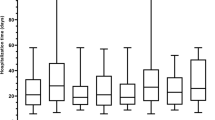Abstract
The objective of this study was to determine if specific species of microorganisms are associated with severe infection and amputation in patients with a diabetic foot infection and to evaluate the effectiveness of clindamycin and ciprofloxacin in this population. A retrospective cohort study was performed at the University Medical Center Utrecht, The Netherlands, for the period January 1st 2005 to January 1st 2010. Patients with ICD-9 codes ‘diabetic foot’ were selected from the hospital database. We evaluated the association of Staphylococcus aureus and Gram-negative species (GNS) with severity of infection, number of amputations, and healing rates. No significant association was found between the different microorganisms and infection severity. Coinfections of GNS and S. aureus were significantly associated with amputation compared to infections with only S. aureus [p = 0.016, odds ratio (OR) 4.9, confidence interval (CI) 1.4–16.9]. The empiric antibiotic regimen of clindamycin and ciprofloxacin covered only 85 % of S. aureus and 78 % of GNS diabetic foot infections. In mild diabetic foot infection in the studied population, where methicillin-sensitive S. aureus and streptococci are the most likely pathogens, a beta-lactam antibiotic such as flucloxacillin would likely be more effective than clindamycin. In moderate and severe infections, where GNS as a causative organism cannot be safely excluded, broad-spectrum antibiotic therapy may be more adequate.
Similar content being viewed by others
References
Adler AI, Boyko EJ, Ahroni JH et al (1999) Lower-extremity amputation in diabetes. The independent effects of peripheral vascular disease, sensory neuropathy, and foot ulcers. Diabetes Care 22(7):1029–1035
Citron DM, Goldstein EJ, Merriam CV et al (2007) Bacteriology of moderate-to-severe diabetic foot infections and in vitro activity of antimicrobial agents. J Clin Microbiol 45(9):2819–2828
El-Tahawy AT (2000) Bacteriology of diabetic foot. Saudi Med J 21(4):344–347
Abdulrazak A, Bitar ZI, Al-Shamali AA et al (2005) Bacteriological study of diabetic foot infections. J Diabetes Complications 19(3):138–141
Lipsky BA, Berendt AR, Cornia PB et al (2012) 2012 Infectious Diseases Society of America clinical practice guideline for the diagnosis and treatment of diabetic foot infections. Clin Infect Dis 54(12):e132–e173
Lipsky BA, Peters EJ, Senneville E et al (2012) Expert opinion on the management of infections in the diabetic foot. Diabetes Metab Res Rev 28(Suppl 1):163–178
Dutch Working Party on Antibiotic Policy. Therapy advice diabetic foot [Stichting Werkgroep Antibiotica Beleid. Therapieadvies diabetische voet]
Armstrong DG, Lavery LA, Vela SA et al (1998) Choosing a practical screening instrument to identify patients at risk for diabetic foot ulceration. Arch Intern Med 158(3):289–292
Bakker K, Apelqvist J, Schaper NC et al (2012) Practical guidelines on the management and prevention of the diabetic foot 2011. Diabetes Metab Res Rev 28(Suppl 1):225–231
Berendt AR, Peters EJ, Bakker K et al (2008) Diabetic foot osteomyelitis: a progress report on diagnosis and a systematic review of treatment. Diabetes Metab Res Rev 24(Suppl 1):S145–S161
Schaper NC (2004) Diabetic foot ulcer classification system for research purposes: a progress report on criteria for including patients in research studies. Diabetes Metab Res 20(Suppl 1):90–95
Senneville E, Melliez H, Beltrand E et al (2006) Culture of percutaneous bone biopsy specimens for diagnosis of diabetic foot osteomyelitis: concordance with ulcer swab cultures. Clin Infect Dis 42(1):57–62
Mutluoglu M, Uzun G, Turhan V et al (2012) How reliable are cultures of specimens from superficial swabs compared with those of deep tissue in patients with diabetic foot ulcers? J Diabetes Complications 26(3):225–229
Sotto A, Richard JL, Combescure C et al (2010) Beneficial effects of implementing guidelines on microbiology and costs of infected diabetic foot ulcers. Diabetologia 53(10):2249–2255
Ramakant P, Verma AK, Misra R et al (2011) Changing microbiological profile of pathogenic bacteria in diabetic foot infections: time for a rethink on which empirical therapy to choose? Diabetologia 54(1):58–64
Lipsky BA, Itani K, Norden C (2004) Treating foot infections in diabetic patients: a randomized, multicenter, open-label trial of linezolid versus ampicillin–sulbactam/amoxicillin–clavulanate. Clin Infect Dis 38(1):17–24
Buter CC, Mouton JW, Klaassen CH et al (2010) Prevalence and molecular mechanism of macrolide resistance in beta-haemolytic streptococci in The Netherlands. Int J Antimicrob Agents 35(6):590–592
Acknowledgments
The authors would like to thank L.J.M. Beks for providing the ICD codes.
Funding
No funding was received for this study.
Conflict of interest
The authors state that they do not have any relevant conflicts of interest. Details are available in the conflict of interest forms at the editor’s bureau.
Author information
Authors and Affiliations
Corresponding author
Rights and permissions
About this article
Cite this article
de Vries, M.G., Ekkelenkamp, M.B. & Peters, E.J.G. Are clindamycin and ciprofloxacin appropriate for the empirical treatment of diabetic foot infections?. Eur J Clin Microbiol Infect Dis 33, 453–456 (2014). https://doi.org/10.1007/s10096-013-1977-7
Received:
Accepted:
Published:
Issue Date:
DOI: https://doi.org/10.1007/s10096-013-1977-7




